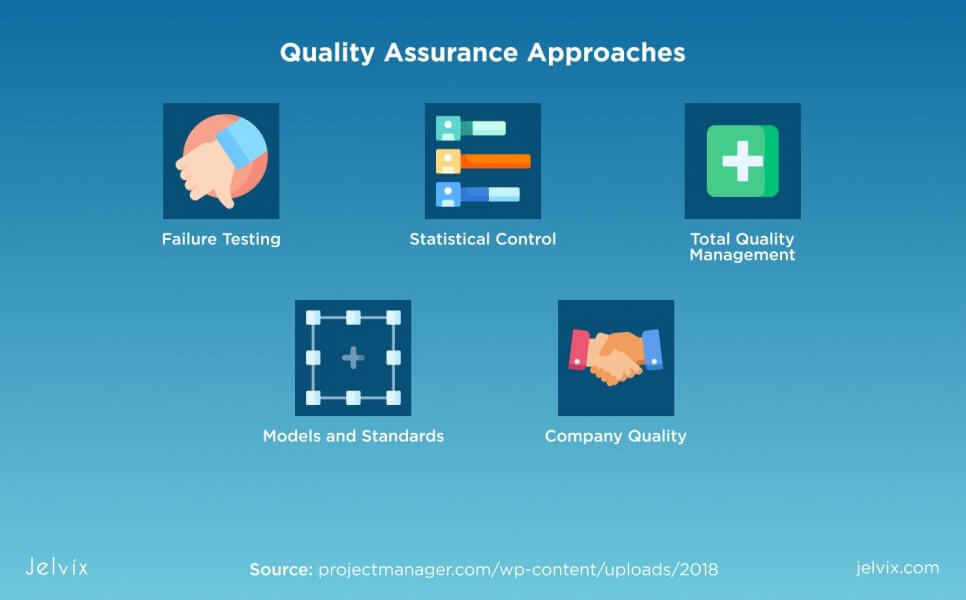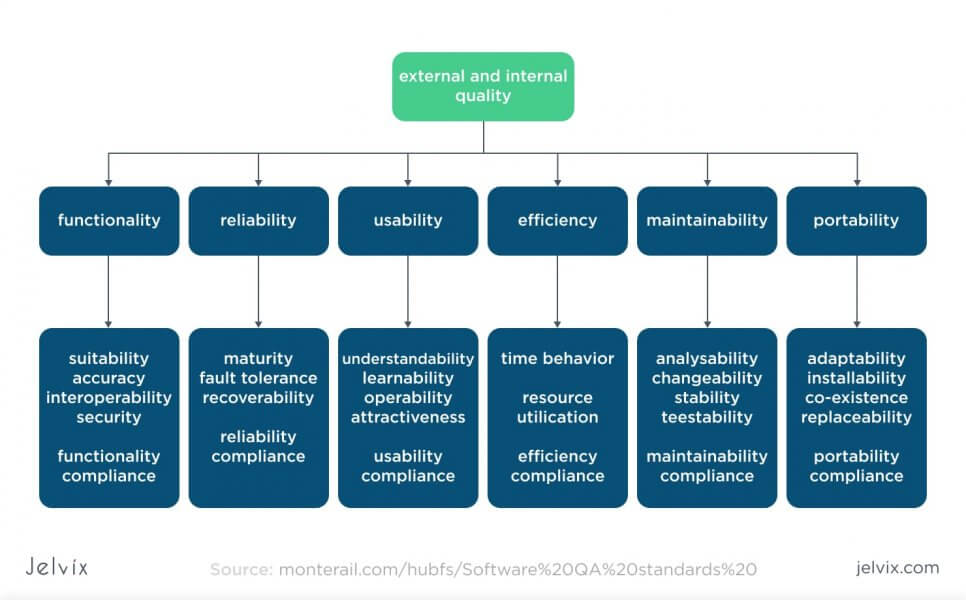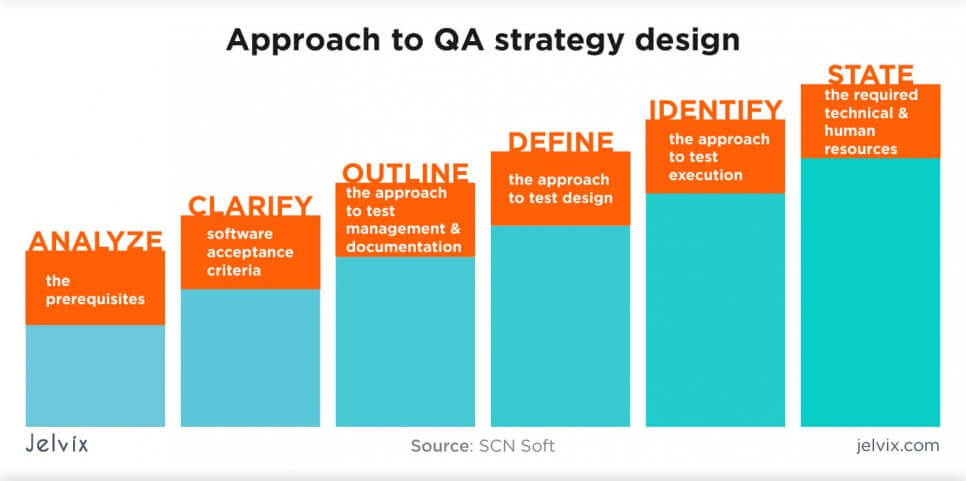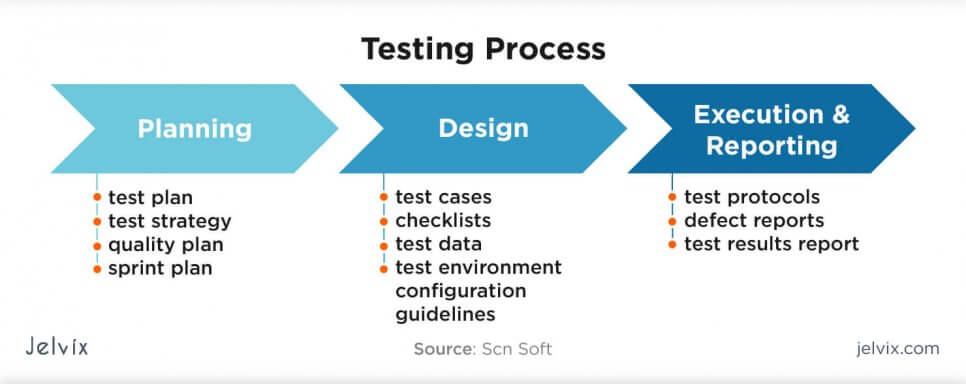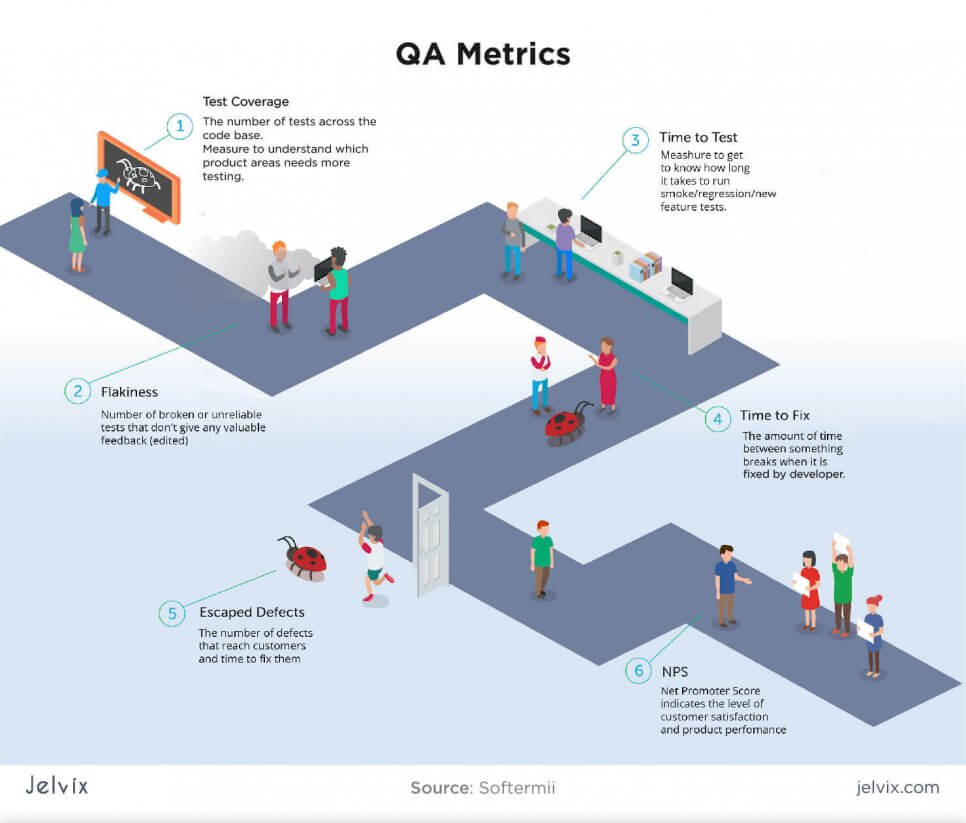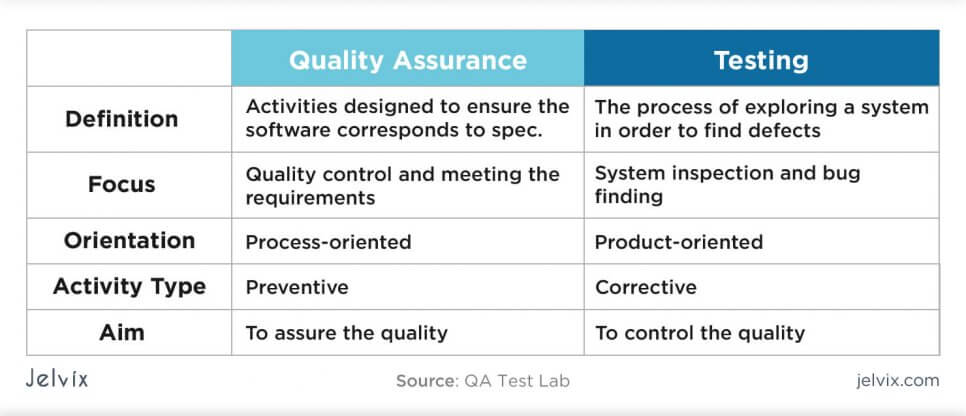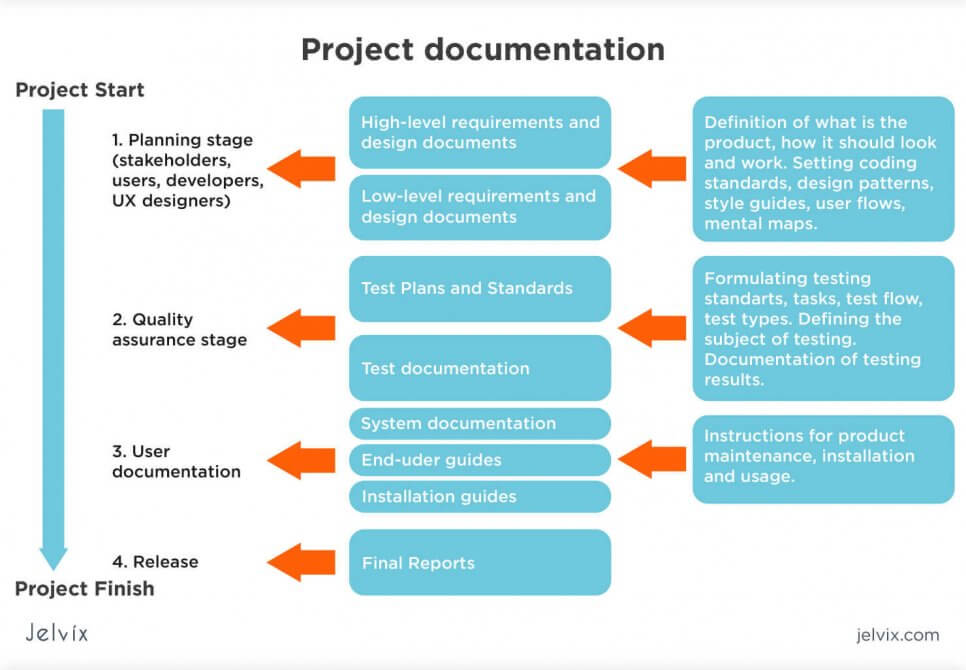Software Quality Assurance has been a key component of software development for dozens of years. QA helps developers and testers increase their work efficiency, cooperate better, automate processes, and see the bigger picture.
When talking to project stakeholders, we noticed that some have misconceptions about QA, either limiting it to testing only or confusing it with Quality Control.
In this guide, we encapsulate our vision of Quality Assurance, define the concept, purpose, and possibilities of software QA. Hopefully, it will be your must-read about Quality Assurance.
What is Software Quality Assurance?
To answer this question clearly, let’s break it down into main components: quality and assurance. By understanding the software quality definition and explaining the concept of assurance, you’ll easily grasp the QA concept.
- Software Quality is the totality of functionality and features of a software product that bear on its ability to satisfy stated or implied needs..
- Assurance is the process of making sure the end result corresponds with quality standards. The team checks if the software provides necessary features in an intuitive way and offers reliable performance.
So, quality assurance is a set of processes for ensuring that a product responds to the best quality standards. The main criteria for the product’s external and internal quality are efficiency, functionality, usability, portability, reliability, and maintainability.
Why QA Testing is Essential for Software Development
Software development and testing are complex processes. There are many details to take into account and a lot of room for error. It’s easy to miss issues like tech debt, security issues, redundant functionality, or duplication. Without software QA, developers and testers would be too caught up in short-term tasks. The product will end up being dangerous and inefficient.
Main advantages of using QA for businesses
- Business safety: registration features, payment gateways, data storage, transfer algorithms, and real-time communication functionality cannot exist without Quality Assurance. A wrong request can breach data of thousands of users, cause payments to be transferred to wrong accounts, or compromise sensitive information (like medical records).
- Cost-efficiency: QA is a definition of saving money early on. Preventing bugs and tech debt is cheaper than cleaning it up – especially because one technical problem might end up affecting the entire codebase.
- Documentation: the QA team will create a comprehensive wiki of the project that can be referred to at any stage of the object.
- Reduced number of post-release fixes: taking care of product’s quality early on leads to a better quality of a released product – and higher user satisfaction.
The stages of Quality Assurance
Quality Assurance starts at the very beginning of the project when a team defines product’s business, use, functional, and non-functional requirements. QA team joins the process to define the software quality standards of an end product. All participants will be able to check their compliance with these criteria and deliver a better result.
So, what is software QA? Essentially, the process of QA can be broken down into 5 key stages: discovering, planning, designing, executing, and improving.
The QA team helps define functional and non-functional software requirements and checks how those correlate with business objectives.
Also, it’s important to make a software specification document: this document describes the expected product in detail and will be used for references by developers, testers, stakeholders, and the marketing team. It’s the main document of the software development process.
Requirements analysis
The first step begins with a careful analysis of the project, its risks, and opportunities. The discovery stage is where all participants of the project meet stakeholders and product owners, understand the business goals behind the project, and the scope of the end software.
- Change management: QA experts identify the areas of the project where the change needs to happen, analyze its impact and benefits, and put up for discussion. The team denies or validates the proposal, and can start building a change.
- Causal analysis: if the project already was active, QA analyzes its previous performance and defines problematic areas. Then experts conduct a causal analysis: they determine why the problem occurred and what could’ve been done to avoid a negative outcome.
Test planning
The planning stage is oriented towards familiarizing yourself with the current situation, whereas planning is focused on ideating the next moves. It’s similar to discovery (because it involves a lot of analysis and research), but the methods are different.
- Writing project requirements: the QA team helps define functional and non-functional software requirements and checks how they correlate with business objectives.
- Software specification document: describes the expected product in detail and will be used for reference by developers, testers, stakeholders, and the marketing team. It’s the main document of the software development process.
- Estimation. The team has already conducted a risk analysis and understood the project scope well. Now they can estimate the duration and cost of the project, and create a software quality assurance plan.
- Risk management: software quality assurance engineers identify risky areas and grade them according to potential consequences. They develop strategies for handling each of those threats and develop a warning system (how a team will find out that a risky situation has occurred). Finally, they plan risk response: avoidance (avoiding risks), reduction (minimizing), acceptance (dealing), and transfer (moving to a vendor or another stakeholder).
Test Design
The QA team’s main objective in a software development project is to create a viable long-term strategy. It will help testers and developers follow the best coding standards, guide Quality Control teams, and measure the end results.
Test artifacts on the design stage
QA and testing stages are characterized by specific activities and documents. At the design stage, the following artifacts are prevalent:
- Test case: a detailed description of testing conditions, procedure, inputs, and results. A test case describes one test and a single objective, related to it. It’s important to keep test cases independent, so they are more precise.
- Test scenario: QA team defines stories that testers need to work through. Each problem is described with a scenario that describes believable, realistic, and clear user motivation. The outcome of working through each testing scenario should be predictable and measurable.
- Test scripts: instructions for testing activities that need to be performed to verify a particular feature. Each function has a different script that describes the best ways of approaching it.
The design stage can be broken down into 6 steps:
- Analysis: the team assesses current human and tech resources, project constraints, and product requirements;
- Clarification: defining software acceptance criteria (what kind of product is defined as “done);
- Outlining: preparing QA documentation for the project;
- Defining software quality assurance testing activities: choosing relevant types of testing and planning their goals along with metrics;
- Identification: determining the approach to testing (quality assurance software, environments, automation, responsible team members, management methodologies);
- Evaluating final state: identifying areas that could be improved and continuously optimizing them.
The design stage of a software quality assurance process is ongoing. As long as the project grows, the team will make updates to QA strategy, seek ways to reduce cost and duration, and automate as many processes as possible.
Test execution
QA is implemented via reports, audits, and protocols. The tasks of a QA team is to keep consistent documentation of the testing and development process, measure the team’s efficiency, check if the end results comply with the envisioned standards. Here’s how execution is connected to planning and design.
Test conclusion
QA experts deal with long-term processes and bigger-picture strategies. Here, having tangible metrics is essential – otherwise, the team will easily lose sight of their scope. Let’s take a look at some common QA metrics and their significance.
- Test Coverage: estimating and measuring the number of executing tests for a given feature of the entire codebase. These metrics allow the team to understand which areas of the project are understated and increase the coverage.
- Time to Test: the team measures the efficiency of the testing process calculating the number of tests and how much time is taken by a particular amount of testing.
- Flakiness: the number of faulty or broken tests that produced not relevant feedback. These metrics allow detecting problems in testing, Quality Assurance, and Quality Control, and avoid inefficient work in the future.
- Time to Fix: measuring how much time the team takes to notice and fix a broken feature. These metrics show the efficiency of code analysis, testing, and fixing.
- Escaped defects: the number of technical issues that went unnoticed by a QA and the testing team and the time taken to fix those post-deployment errors.
- NPS: (a Net Promoter Score) allows measuring customer satisfaction from using the product. Users’ feedback provides clear insights into the product’s quality, performance, intuitive interface, and usability.
Using these main QA metrics provides QA testers, QC team members, testing specialists, product owners, and project managers with a clear understanding of the team’s accomplishments, and remaining problematic areas.
Test closure
The closure of the testing process is a process when testers make conclusions, based on the results. The team conducts meetups, analyzes metrics, user feedback, and performance.
Here, testing metrics are also the most important artifact of the process. Testers need to track the number of fixed defects, escaped bugs, completed tests. While conducting the closure, teams identify new opportunities and activities.
Optimize your product development process with key strategies and best practices to enhance efficiency and drive growth.
Differences between Quality Control and Quality Improvement
Quality assurance is sometimes confused with similar terms – most notably, quality control and improvement. We have a guide for that – be sure to take a look – because in this article we’ll only give a brief distinction.
Quality Assurance is a process-oriented field: the team is focused on optimizing development and testing processes with SQA methodologies.
Quality Control is a product-oriented field: testers are focused on delivering a high-quality product. The methods for this are defined by the QA team: the only concern of the QC team is cleaning up the product.
Quality improvement is a set of practical activities that a team does to improve the development and testing process. It’s often done by QA specialists, but big companies sometimes prefer dedicating a separate team for this field. A general distinction is that QA is more theory-based and analytical, where QI is practical and actionable.
Quality Assurance and Testing
These two terms are often used as synonyms, but in fact, they aren’t. Even though QA experts are often also capable of performing software testing, it doesn’t mean that the two fields are the same. In fact, QA differs from testing in its definition, focus, aim, activity type, and orientation.
Quality assurance defines the areas where testing needs to be performed, provides testing frameworks, architecture, and assigns quality assurance software. It handles all the organizational aspects of testing – but not the work itself.
Testers aren’t focused on organizing the process, their main work scope is inside the product.
Quality Assurance risks
Quality Assurance is a process that’s designed to minimize the risk of software testing and development projects. However, QA comes along with some risks that teams need to be aware of before hiring or onboarding QA experts. In our experience, companies who start implementing quality assurance for the first time, usually deal with the following risks.
As you can see, QA risks can be navigated early on in the project. The majority of potential threats lie at the hiring and discovery stages. If you pay attention to miscommunications, estimation faults, and cooperation difficulties right away, you will be able to avoid the majority of potential problems.
Competences of Software Quality Assurance engineers
Although QA engineers have to keep in the loop with the technical aspect of testing and quality management, the most important aspect is their analytical, management, and insightful abilities. A QA expert should be able to act practically but also to distance himself and see the project from the bird-eye view.
Key qualities of a software QA engineer
- Deep knowledge of testing documentation (test cases, reports, checklists, estimates) and its automation;
- Knowledge of several bug tracking systems and experience of their practical application;
- The knowledge of QA and testing management platforms;
- Understanding of QA metrics and tools for their management;
- Experience of conducting a product discovery stage, writing a software specification document, defining product requirements, and estimating the project’s budget;
- Designing QA scenarios and processes: a QA expert should be able to quickly come up with solutions for sudden technical issues, automate the entire testing areas, and analyze system behavior as a whole.
- Cooperation and management: QA teams are the ones to take the initiative for implementing innovative methods and approaches. They should be ready to communicate with all team members and stakeholders, and present their ideas in a clear and concise way.
- Practical knowledge of software development methodologies: Agile, DevOps, Kanban, Waterfall, etc.
QA engineer responsibilities:
- Analyze test results, escaped defects, and discovered bugs;
- Advise improvements in software quality to QC and development teams;
- Cooperate with developers and enhance the process;
- Research similar products on the market;
- Keep the team up to speed with technology, trends, and standards;
The QA team lead should, on top of that, possess a highly business-oriented mindset. The QA specialist should always look back on business and user objectives and make sure that the end product is in line with these initial expectations. Understanding the connection between the QA processes and business processes (increasing revenue, expansion) is a key competency for a QA lead.
Learn the role of the Software Testing Life Cycle (STLC). Software Testing Life Cycle is a sequence of systematic activities during the software testing process.
How to choose the Quality Assurance team?
Choosing a QA team is the most important step in creating a successful QA department in your enterprise. We recommend engaging outsourcing experts even if you have in-house specialists: the influx of new ideas and methodologies will expand your team’s view, enrich your practices, and improve the end quality.
We always ask our clients how they chose the QA team and about their selection criteria – here’s a brief checklist of what they usually tell us.
- Caring about the needs of the business. If QA teams want to know about the specifics of business operations, objectives, needs, and plans, the product owner can be sure that they have enough context to understand business requirements.
- Experience with building and using custom tools. Although the QA field offers a lot of ready-to-go tools and mechanisms, it’s always appreciated if the team uses their own devices and platforms to deliver better efficiency and product quality. The use of custom tools shows the team’s creativity and complex approach to QA.
- Different modes of cooperation. Team’s flexibility in outsource work, as a dedicated team, or hire on demand is often a deciding factor. QA testers must be open for many cooperation options, in case the company decides to redesign the workflow.
- Experience and reviews. Checking platforms like Clutch and GoodFirms helps to get an objective view of the company’s expertise, case studies, and approved reviews.
- Team’s skills: professional QA teams have experts in different testing types, both with a theoretical background and technical experience. If QA experience worked in quality control at some point, it’s also an advantage. The team should be familiar with different types of projects, tech stacks, testing tools, and frameworks.
- Detailed and ordered documentation. Quality Assurance is often about analyzing, researching, and reporting. The team must have high standards for their documentation quality, use automation tools to reduce time expenses, and use precise metrics to back up their motivations with tangible data.
- Analytical skills for business assessment, product, creating requirements, and specifications. A professional team will be the first to encourage you to have a detailed conversation about your goals and objectives, and walk you through the flaws of existing systems. A QA professional is always eager to discuss ways in which the system can be improved.
An expert QA team will openly share their experience, examples of documentation, previous projects, and reviews. They will also share what went wrong and how it was fixed. The QA team that doesn’t talk about the problems that arose during the project likely lacks transparency. Honest communication is another important criterion for choosing QA experts.
Best practices of Quality Assurance
If you are already working with a QA team but looking for ways to increase your efficiency, you might consider revisiting the best practices. It’s possible that your team is not implementing some of the crucial processes that make a difference in QA performance.
Practice 1 – Using an ERP to manage the QA process
You can use ERPs that are developed specifically for Quality Assurance like GreenLightGuru or QT9QMS. ERP solutions allow measuring the team’s efficiency automatically, transparently view the activities of all members, automatically generate documentation, and manage inspections.
Practice 2 – Getting feedback from the end-users
Talking to customers gives QA specialists perspective on their activities. Ensuring that testers and developers, as well as QA teams, get access to focus groups, reviews, and ratings is highly important.
- You can schedule remote calls with users where the technical team observes the experience of using a product;
- Encourage the QA team to go through product reviews;
- Start an email campaign where users are encouraged to write a review in exchange for a discount or special offers.
Getting fast reviews and shortening the feedback loop between QA testers and users makes it easier for quality assurance teams to update their practices and understand what could be optimized.
Practice 3 – Encourage constant improvement
The entire point of quality assurance is process optimization. The team should be encouraged to try out new methods, innovate, and eliminate inconsistencies. A similar process should be performed with the product – there should be no unnecessary features, operations, or user actions.
Practice 4 – Documentation
The QA team should have a wiki where they record technical issues, their causes, escaped effects, and their details. Keeping comprehensive documentation will make maintenance and onboarding easier.
It’s important to rate the priority of QA tasks and risks – the team will be focused on the essential processes first. You should also have a responsible manager for each task who is held accountable for delivering a high-quality result.
Practice 5 – Integration
The QA team should cooperate with the entire team involved in the project. This includes developers, testers, quality control, marketing and communication, designers, customer success, business analysts, etc. Cooperating with departments that talk to users and technical support is especially important because it provides a direct insight into users’ needs.
Conclusion
Quality Assurance is crucial for any software development project. It’s the only field in software development and testing whose priority is efficiency and optimization. An expert Quality Assurance team will elevate the coding standards in the team, help deliver a better product, and nurture higher user satisfaction. Having a QA team is almost a guarantee that your team and project will always move forward.
Compromising on QA leads to the team’s stagnation and deterioration of product quality. Unfortunately, we’ve seen this, too – business owners and managers neglected QAS early on and turned to our experts with requests for fixing live services.
Obviously, such fixes are more expensive than the prevention of issues – ultimately, the teams end up paying more and disappointing their users.
If you are considering any development project, QA should definitely be a part of it. Without assurance in the early stages, too many things could go wrong. To get started with QA now, get in touch with our QA team – we’ll discuss the details of the project and our involvement.
Need a certain developer?
Use our talent pool to fill the expertise gap in your software development.


